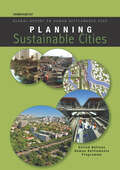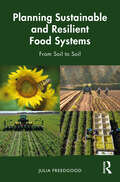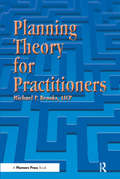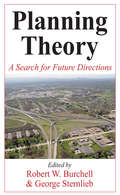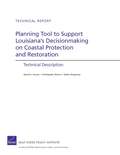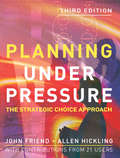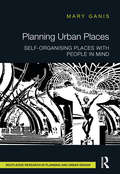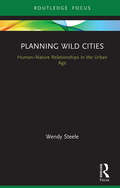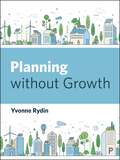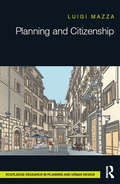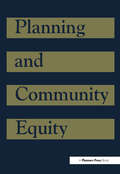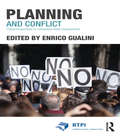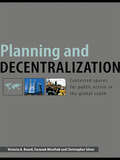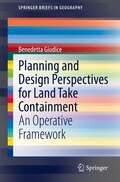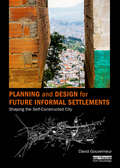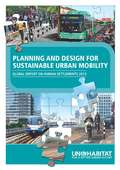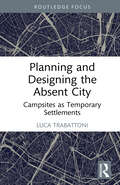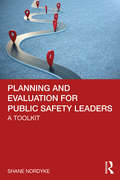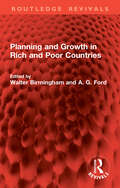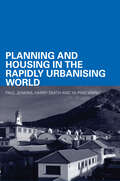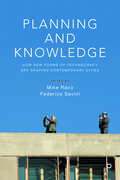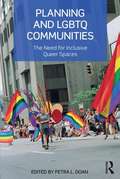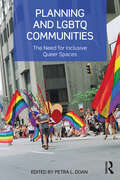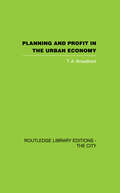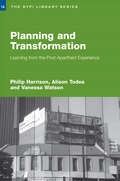- Table View
- List View
Planning Sustainable Cities: Global Report on Human Settlements 2009
by Un-HabitatCurrent urban planning systems are not equipped to deal with the major urban challenges of the twenty-first century, including effects of climate change, resource depletion and economic instability, plus continued rapid urbanization with its negative consequences such as poverty, slums and urban informality. These planning systems have also, to a large extent, failed to meaningfully involve and accommodate the ways of life of communities and other stakeholders in the planning of urban areas, thus contributing to the problems of spatial marginalization and exclusion. It is clear that urban planning needs to be reconsidered and revitalized for a sustainable urban future. Planning Sustainable Cities reviews the major challenges currently facing cities and towns all over the world, the emergence and spread of modern urban planning and the effectiveness of current approaches. More importantly, it identifies innovative urban planning approaches and practices that are more responsive to current and future challenges of urbanization. The Global Report on Human Settlements is the most authoritative and up-to-date global assessment of human settlements conditions and trends. It is an essential reference for researchers, academics, public authorities and civil society organizations all over the world. Preceding issues of the report have addressed such topics as Cities in a Globalizing World, The Challenge of Slums, Financing Urban Shelter and Enhancing Urban Safety and Security.
Planning Sustainable and Resilient Food Systems: From Soil to Soil
by Julia FreedgoodCovid-19 was a canary in a mine. It exposed the vulnerabilities of 21st-century food systems but did not create them. Since then, the world has faced a “polycrisis:” a cluster of weather-related crop failures, war-induced food and energy shortages, and import dilemmas with compounding effects. Going forward, we need to plan for more sustainable and resilient food systems that improve environmental outcomes and address economic disparities. But food systems planning is a relatively new discipline and guidance is scarce. This book fills that gap.Where most food systems planning has focused on urban issues, this book takes a holistic view to include rural communities and production agriculture whose stewardship of the earth is so critical to public and environmental health, as well as to ensuring a varied and abundant food supply. Its goal is to inform planning practices and follow-up actions for a wide range of audiences—from professional planners, planning commissions, and boards to conservation districts and Cooperative Extension to the on-the-ground change-makers working to strengthen America’s food and farming systems. Embracing the fact that the U.S. is highly diverse in its people, places, and politics, the book lifts up principles and successful examples to help communities develop strategies based on their unique assets and the needs and preferences of their people.
Planning Theory for Practitioners
by Michael BrooksThis book is recommended reading for planners preparing to take the AICP exam. In this new book, the author bridges the gap between theory and practice. The author describes an original approach-Feedback Strategy-that builds on the strengths of previous planning theories with one big difference: it not only acknowledges but welcomes politics-the bogeyman of real-world planning. Don't hold your nose or look the other way, the author advises planners, but use politics to your own advantage. The author admits that most of the time planning theory doesn't have much to do with planning practice. These ideas rooted in the planner's real world are different. This strategy employs everyday poltiical processes to advance planning, trusts planners' personal values and professional ethics, and depends on their ability to help clients articulate a vision. This volume will encourage not only veteran planners searching for a fresh approach, but also students and recent graduates dismayed by the gap between academic theory and actual practice.
Planning Theory: A Search for Future Directions
by Robert W. BurchellTheory and practice in city planning have never been known for their compatibility. The planner, dealing with stresses such as the personalities at work in a board meeting and coping with the realities of fund raising, political realities, and the like, can find little guidance in the theory of the trade. The issues of poverty groups, whether rural or urban, the provision of services, and the packaging of them are seemingly insuperable. The sheer frustration in the inability to deliver, which so many planners feel, can result in considerable impatience and a questioning of the relevance of theory.The editors argue that this state of affairs, though understandable, is unacceptable. While short-range meliorismwithout sense of perspective may be good for the practitioner's individual psyche, the cost may be borne by the long-run best interests of the groups to be served. The risks of a lack of perspective and the experiences generated by this phenomenon are too serious in their implications to permit the process to continue.In this new age of anxiety it is essential for both planners and theorists to understand their roles as well as provide guidance in shaping them. Burchell and Sternlieb have thus gathered here a variety of individuals, all of whom in their separate and distinct fashions are seasoned, both in practice and in theory. The book is divided into five sections: Physical Planning in Change, Social Planning in Change, Public Policy Planning in Change, Economic Planning in Change, and a final section detailing the roles of planners and who they are. These shared puzzlements and insights will prove useful to all practitioners and theorists in the planning field.
Planning Tool to Support Louisiana's Decisionmaking on Coastal Protection and Restoration
by David G. Groves * Christopher Sharon * Debra KnopmanA computer-based decision-support tool, called the Coastal Protection and Restoration Authority (CPRA) Planning Tool, provided technical analysis that supported the development of Louisiana's Comprehensive Master Plan for a Sustainable Coast through CPRA and community-based deliberations. This document seeks to provide an accessible technical description of the Planning Tool and associated analyses used to develop the Master Plan.
Planning Under Pressure
by John Friend Allen HicklingPlanning under Pressure offers managers, planners, consultants and students a comprehensive and authoritative guide to the Strategic Choice Approach, which has gradually been attracting worldwide recognition as a fresh, versatile and practical approach to collaborative decision-making under uncertainty. Starting from basic principles, the book uses helpful diagrams and clear explanations to demonstrate practical ways of approaching daunting decision problems; of devising possible ways forward; and of working effectively towards agreed courses of action. Along he way, decision makers are helped to cope with diverse sources of uncertainty – technical, political, managerial – in a strategic manner.In this extended third edition, the authors have added short contributions from 21 users from seven countries. These new contributors present lessons from their varied experiences in adapting the Strategic Choice Approach to guide decision-making and learning in settings ranging from the re-routing of a controversial city carnival procession to national policy for the management of nuclear waste.
Planning Urban Places: Self-Organising Places with People in Mind
by Mary GanisUrban change is often difficult because we are dealing with people’s elusive notions of place and perception, time and change. Urban design and planning in a changing urban context so that it remains relevant for people is elusive because the idea of place is embedded in memory and identity – but whose memory and whose identity? This book seeks to understand the urban change dynamic so that the planning of urban places aligns with the dynamic of people’s perception of place. Planning Urban Places examines the premise that building cities is a concrete business surrounded by a shifting context. It discusses the notion of urban design and placemaking from the perspective of place perception and cognitive psychology, place philosophy and human geography. It also considers network theory to help illustrate the self-organising paradigm of small word network theory for planning urban places.
Planning Wild Cities: Human–Nature Relationships in the Urban Age (Routledge Research in Sustainable Urbanism)
by Wendy SteeleThis book critically engages with the contemporary challenges and opportunities of wild cities in a climate of change. A key focus of the book is exploring the nexus of possibilities for wild cities and the eco-ethical imagination needed to drive sustainable and resilient urban pathways. Many now have serious doubts about the prospects for humanity to live within cities that are socially just and responsive to planetary limits. Is it possible for planning to better serve, protect and nurture our human and non-human worlds? This book argues it is. Drawing on international literature and Australian case examples, this book explores issues around climate change, colonization, urban (in)security and the rights to the city for both humans and nature. It is within this context that this book focuses on the urgent need to better understand how contemporary cities have changed, and the relational role of planning within it. Planning Wild Cities will be of particular interest to students and scholars of planning, urban studies, and sustainable development, and for all those invested in re-shaping our ‘wild’ city futures.
Planning Without Growth
by Yvonne RydinMany planning systems are currently locked into growth-dependence, encouraging market-led development which can widen social inequalities and produce adverse environmental outcomes. This accessible book introduces students to the debates around growth and planning and sets out the solutions to promote genuinely sustainable communities. It includes: • a positive proposal for reform of the planning system; • focused discussions from the UK and Europe providing lessons for future planning; • analysis of the challenges of implementing reform. Covering chapters on cooperatives, community land trusts, local economic development and community assets and infrastructure, as well as commoning, it provides a roadmap for planning system reform with social justice and sustainability at its heart.
Planning and Citizenship
by Luigi MazzaPlanning is undergoing a period of profound change and risks losing meaning and authority by becoming merely a tool for financial speculation and generating capital. Planning and Citizenship seeks to rediscover planning’s technical and theoretical roots by reconstructing the memory of planning through the lens of the changing relationship between planning and citizenship. Tracing the historical relationship between planning and citizenship through a single thread, Luigi Mazza employs three ancient models – those of Hippodamus, Romulus, and Ancient China – to understand the foundations of spatial governance and citizenship. Paying particular attention to classic case studies of American cities, this book moves through the development of central planning theories by key thinkers like Geddes, Cerdà, Howard, Abercrombie and Lefebre. Analysing the role of government in promoting social citizenship and symbolic values through planning, Mazza takes into account the changing role of government in planning, including concepts of neoliberalism and the minimal State. Providing critical debate over the current role of spatial governance in planning and citizenship, Planning and Citizenship offers a unique historical analysis of a crucial topic in planning.
Planning and Community Equity: A Component of APA's Agenda for America's Communities
by American Institute of Certified PlannersThis thought-provoking book exhorts planners to establish community development programs that achieve greater social and economic equity. Some of the 13 chapters urge planners to incorporate community equity concerns into traditional planning areas such as transportation and economic development. Others challenge planners to get more involved in social areas such as urban education and community policing. Each chapter is authored by one or more professionals with expertise in the subject at hand. A helpful resource for planners who continue to tackle the problems of inequality.
Planning and Conflict: Critical Perspectives on Contentious Urban Developments (RTPI Library Series)
by Enrico GualiniPlanning and Conflict discusses the reasons for conflicts around urban developments and analyzes their shape in contemporary cities. It offers an interdisciplinary framework for scholars to engage with the issue of planning conflicts, focusing on both empirical and theoretical inquiry. By reviewing different perspectives for planners to engage with conflicts, and not simply mediate or avoid them, Planning and Conflict provides a theoretically informed look forward to the future of engaged, responsive city development that involves all its stakeholders.
Planning and Decentralization: Contested Spaces for Public Action in the Global South
by Faranak Miraftab Christopher Silver Victoria A. BeardThe first in-depth study of the impact of economic and political decentralization on planning practice in developing economies, this innovative volume, using original case study research by leading experts drawn from diverse fields of inquiry, from planning to urban studies, geography and economics, explores the dramatic transformation that decentralization implies in responsibilities of the local planning and governance structures. It examines a range of key issues, including: public and private finance local leadership and electoral issues planning in post-conflict societies. Offering unique insights into how planning has changed in specific countries, paying particular attention to South East Asian economies, India and South Africa, this excellent volume is an invaluable resource for researchers, graduate students and planners interested in urban planning in its international political and economic context.
Planning and Design Perspectives for Land Take Containment: An Operative Framework (SpringerBriefs in Geography)
by Benedetta GiudiceThis book aims to provide a framework for the concept of land take, the practice by which natural lands are lost to artificial land development practices, and present its ecological implications in urban environments. In particular, the book intends to contextualize land take and its ecological implications in the field of planning through the analysis of the evolution of the relationship that exists between ecology and urban and regional planning, with case studies focusing on cities in Europe. Urban and regional planning (specifically in terms of tools, policies and strategies) play a central role in the redevelopment of this relationship, and through this perspective the text explores some operational criteria and guiding strategies for the creation of innovative scenarios of planning and design. The book is indeed mainly based upon an ecological planning-oriented perspective, with the attempt of creating a strong link between the plan and the project that will be useful for students, researchers, policy makers, and urban planners and designers.
Planning and Design for Future Informal Settlements: Shaping the Self-Constructed City
by David GouverneurThis is the first book to address future informal settlements at the global scale. It argues that to foster favourable conditions for the sustainable evolution of future informal cities, planners must consider the same issues that are paramount in formal urban developments, such as provision of: balanced land uses energy efficiency and mobility water management and food sufficiency governance and community participation productivity and competitiveness identity and sense of place Planning and Design for Future Informal Settlements makes a call for responsible action to address the urban challenges of the developing world, suggesting that the vitality of informality, coupled with spatial design and good management, can support the efficient use of resources in better places to live. The book analyses the strengths and weaknesses of informal urbanism and the challenges faced by the fast growing cities of the developing world. Through case studies, it demonstrates the contributions and limitations of different attempts to plan ahead for urban growth, from the creation of formal housing and urban infrastructures for self-built dwellings to the improvement of existing informal settlements. It provides a robust framework for planners and designers, policy-makers, NGOs and local governments working to improve living conditions in developing cities.
Planning and Design for Sustainable Urban Mobility: Global Report on Human Settlements 2013
by Un-HabitatUrban transport systems worldwide are faced by a multitude of challenges. Among the most visible of these are the traffic gridlocks experienced on city roads and highways all over the world. The prescribed solution to transport problems in most cities has thus been to build more infrastructures for cars, with a limited number of cities improving public transport systems in a sustainable manner. However, a number of challenges faced by urban transport systems – such as greenhouse gas emissions, noise and air pollution and road traffic accidents – do not necessarily get solved by the construction of new infrastructure. Planning and Design for Sustainable Urban Mobility argues that the development of sustainable urban transport systems requires a conceptual leap. The purpose of ‘transportation’ and ‘mobility’ is to gain access to destinations, activities, services and goods. Thus, access is the ultimate objective of transportation. As a result, urban planning and design should focus on how to bring people and places together, by creating cities that focus on accessibility, rather than simply increasing the length of urban transport infrastructure or increasing the movement of people or goods. Urban form and the functionality of the city are therefore a major focus of this report, which highlights the importance of integrated land-use and transport planning. This new report of the United Nations Human Settlements Programme (UN-Habitat), the world’s leading authority on urban issues, provides some thought-provoking insights and policy recommendations on how to plan and design sustainable urban mobility systems. The Global Report on Human Settlements is the most authoritative and up-to-date global assessment of human settlements conditions and trends. Preceding issues of the report have addressed such topics as Cities in a Globalizing World, The Challenge of Slums, Financing Urban Shelter, Enhancing Urban Safety and Security, Planning Sustainable Cities and Cities and Climate Change.
Planning and Designing the Absent City: Campsites as Temporary Settlements
by Luca TrabattoniThis book concerns the study of open-air accommodation facilities. The market evolutions allow us to look at these structures as temporary settlements characterised by a low-density dwelling and a close connection with natural elements and the landscape.This new and different point of view is sustained by the tendency of outdoor tourism to go in the direction of temporary villages, and this tendency is directly related to "time" and "landscape". The landscape is the reason why the campsite is settled. The time is linked to the holiday season timing. Today, both are greatly influenced by the introduction of the "Maxi-Caravan". This removable living unit can be placed on the empty pitch, occupying the landscape without ruining the soil. By the settlement of Maxi-Caravans, the campsite is transformed from an empty landscape with tents to a temporary settlement, whose timing is divided between the seasonal timing of the campsite and the "timing" of the product, and whose landscape is organised by the relation with the prevalent landscape and the internal one. The book's core defines the outdoor facility structure, using Italy as the main case study. To identify design strategies, the book analyses temporary settlement examples (quick time) and projects from historic outdoor tourism (medium time). Finally, the last chapter reflects on open-air accommodation facilities by showing their applicability in the different contexts of the refugee camps (long time).The aim of this research is to enhance the theme of open-air accommodation facilities, highlighting the need to equalise the study of temporary settlements with that of permanent settlements. It will be of interest to researchers and students of planning, landscape and tourism.
Planning and Evaluation for Public Safety Leaders: A Toolkit
by Shane NordykePlanning and Evaluation for Public Safety Leaders presents field-tested techniques and tips to help public safety leaders effectively manage their organizations and overcome challenges. Organizations and agencies operating within the public safety sector are unique in many respects. These unique elements provide a different context in which planning, and performance measurement occur. Without recognizing this particular context, most public planning texts ignore crucial pieces of the puzzle when it comes to effectively achieving and measuring public safety outcomes. This book’s practical approach equips students with approachable explanations specific to the public safety context, and practical tools for public safety leaders that can apply to their organizations. Key Features • Each chapter begins with a real-world case from the public safety sector that highlights the importance or possible application of the information covered. • Cases are written in close coordination with the public safety practitioners to illustrate how the concepts covered in the chapter work in a real-world public safety context. • "Put it into Practice" Reflections at the end of each chapter allow new or future public safety leaders to apply the material directly to their current organization. • Boxes describe how to use and apply specific methods in a concise and easy to find tools addressing planning and evaluation challenges as they arise • Key terms and application questions written specifically for students, focus in on the most important concepts and terms from the text. • Overviews of relevant theoretical and scholarly work on the concepts offer connections with course material.
Planning and Growth in Rich and Poor Countries (Routledge Revivals)
by A. G. Ford Walter BirminghamOriginally published in 1966, this book was written at a time when economists realized that rapid growth in developing nations could not be achieved without comprehensive planning and that no economy could be left to grow of its own accord without the danger of major fluctuations in economic activity and long periods of stagnation. Written by a team of academic economists who combined specialized knowledge of the theory of economic growth with world-wide experience of its practical applications, this volume provides an intelligent analysis of the problems of economic growth which faced nations that had embarked on the planning of their economies such as the UK, India, Ghana, Sierra Leone and New Zealand.
Planning and Housing in the Rapidly Urbanising World (Housing, Planning and Design Series)
by Harry Smith Paul Jenkins Ya Ping WangWritten specifically as a teaching text and authored by a team of leading academics in the field, this is the first book to bring together the key issues of rapid urbanisation with approaches to planning and housing. Outlining and explaining core concepts from ‘informal settlements’ to ‘sustainability’, it focuses on the rapid urbanization of developing countries with case studies from Latin America, Asia and Sub-Saharan Africa. The impact of rapid urbanization and associated globalization on land-use and housing is described and analyzed with reference to the particular issues of poverty, health and the environment of these areas. Providing an accessible introduction to the key issues as well as enhancing current theoretical debates and exploring practical applications, this book is an essential resource for students and researchers in this area.
Planning and Knowledge: How New Forms of Technocracy Are Shaping Contemporary Cities
by Mike Raco and Federico SaviniThis book uses an international perspective and draws on a wide range of new conceptual and empirical material to examine the sources of conflict and cooperation within the different landscapes of knowledge that are driving contemporary urban change. Based on the premise that historically-established systems of regulation and control are being subject to unprecedented pressures, scholars critically reflect on the changing role of planning and governance in sustainable urban development, looking at how a shift in power relations between expert and local cultures in western planning processes has blurred the traditional boundaries between public, private, and voluntary sectors.
Planning and LGBTQ Communities: The Need for Inclusive Queer Spaces
by Petra L. DoanAlthough the last decade has seen steady progress towards wider acceptance of lesbian, gay, bisexual, transgendered, and queer (LGBTQ) individuals, LGBTQ residential and commercial areas have come under increasing pressure from gentrification and redevelopment initiatives. As a result many of these neighborhoods are losing their special character as safe havens for sexual and gender minorities. Urban planners and municipal officials have sometimes ignored the transformation of these neighborhoods and at other times been complicit in these changes. <p><p> Planning and LGBTQ Communities brings together experienced planners, administrators, and researchers in the fields of planning and geography to reflect on the evolution of urban neighborhoods in which LGBTQ populations live, work, and play. The authors examine a variety of LGBTQ residential and commercial areas to highlight policy and planning links to the development of these neighborhoods. Each chapter explores a particular urban context and asks how the field of planning has enabled, facilitated, and/or neglected the specialized and diverse needs of the LGBTQ population. <p> A central theme of this book is that urban planners need to think "beyond queer space" because LGBTQ populations are more diverse and dispersed than the white gay male populations that created many of the most visible gayborhoods. The authors provide practical guidance for cities and citizens seeking to strengthen neighborhoods that have an explicit LGBTQ focus as well as other areas that are LGBTQ-friendly. They also encourage broader awareness of the needs of this marginalized population and the need to establish more formal linkages between municipal government and a range of LGBTQ groups. Planning and LGBTQ Communities also adds useful material for graduate level courses in planning theory, urban and regional theory, planning for multicultural cities, urban geography, and geographies of gender and sexuality.
Planning and LGBTQ Communities: The Need for Inclusive Queer Spaces
by Petra L. DoanAlthough the last decade has seen steady progress towards wider acceptance of lesbian, gay, bisexual, transgendered, and queer (LGBTQ) individuals, LGBTQ residential and commercial areas have come under increasing pressure from gentrification and redevelopment initiatives. As a result many of these neighborhoods are losing their special character as safe havens for sexual and gender minorities. Urban planners and municipal officials have sometimes ignored the transformation of these neighborhoods and at other times been complicit in these changes. Planning and LGBTQ Communities brings together experienced planners, administrators, and researchers in the fields of planning and geography to reflect on the evolution of urban neighborhoods in which LGBTQ populations live, work, and play. The authors examine a variety of LGBTQ residential and commercial areas to highlight policy and planning links to the development of these neighborhoods. Each chapter explores a particular urban context and asks how the field of planning has enabled, facilitated, and/or neglected the specialized and diverse needs of the LGBTQ population. A central theme of this book is that urban planners need to think "beyond queer space" because LGBTQ populations are more diverse and dispersed than the white gay male populations that created many of the most visible gayborhoods. The authors provide practical guidance for cities and citizens seeking to strengthen neighborhoods that have an explicit LGBTQ focus as well as other areas that are LGBTQ-friendly. They also encourage broader awareness of the needs of this marginalized population and the need to establish more formal linkages between municipal government and a range of LGBTQ groups. Planning and LGBTQ Communities also adds useful material for graduate level courses in planning theory, urban and regional theory, planning for multicultural cities, urban geography, and geographies of gender and sexuality.
Planning and Profit in the Urban Economy
by T.A. BroadbentFirst Published in 2006. This text tries to answer some of the questions posed in the introduction to the British edition of 'After the Planners'- what is the relationship between government and industry and what is the role of planning within his relationship.
Planning and Transformation: Learning from the Post-Apartheid Experience (RTPI Library Series)
by Vanessa Watson Alison Todes Philip HarrisonPlanning and Transformation provides a comprehensive view of planning under political transition in South Africa, offering an accessible resource for both students and researchers in an international and a local audience. In the years after the 1994 transition to democracy in South Africa, planners believed they would be able to successfully promote a vision of integrated, equitable and sustainable cities, and counter the spatial distortions created by apartheid. This book covers the experience of the planning community, the extent to which their aims were achieved, and the hindering factors. Although some of the factors affecting planning have been context-specific, the nature of South Africa’s transition and its relationship to global dynamics have meant that many of the issues confronting planners in other parts of the world are echoed here. Issues of governance, integration, market competitiveness, sustainability, democracy and values are significant, and the particular nature of the South African experience lends new insights to thinking on these questions, exploring the possibilities of achievement in the planning field.
